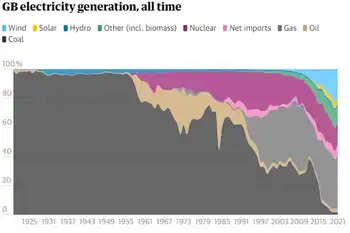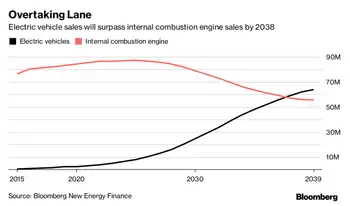Garbage in, energy out
By Globe and Mail
Electrical Testing & Commissioning of Power Systems
Our customized live online or in‑person group training can be delivered to your staff at your location.

- Live Online
- 12 hours Instructor-led
- Group Training Available
Municipal garbage trucks — diverted from the city landfill across the road — dump their loads of solid waste on the concrete floor, where a front-end loader moves the garbage into a shredder that also removes metals for recycling.
The shredded waste is then pushed into piles where it can be fed onto a conveyor belt that delivers it to the company's patented plasma-gasification system.
In harnessing that energy, Plasco chemically transforms Ottawa's residential garbage into a synthetic gas that is used to generate electricity — without emitting greenhouse gases. The process also produces some commercial byproducts such as sulphur, water and solid aggregate.
It's a 21st-century form of alchemy: garbage in, energy out. In a time when municipalities are desperate to reduce greenhouse gases and relieve overflowing landfills, gasification has the potential to be a world-changing technology.
But as with many green energy technologies, success depends on another modern dark art: raising capital.
If Plasco doesn't succeed on that front, it won't be for lack of trying. For the man in charge is Ottawa's most battle-scarred serial entrepreneur, Rod Bryden, late of SHL Systemhouse Ltd., Kinburn Technologies, WorldHeart Corp. and the Ottawa Senators.
But Plasco's technology has run into some serious glitches, which have hindered the company's ability to raise money.
Mr. Bryden, 65, is undaunted. "We believe that our manufactured product can be the most commonly used method of handling waste in the world."
The landscape is littered with technologies that promised breakthrough advances in efficiency or environmental benefit, but failed to clear commercial hurdles. And it's already been a long haul for Plasco.
Five years ago, the company's founders, including current executive vice-president Christopher Gay and chief technology officer Andreas Tsangaris, realized they needed a savvy business partner and turned to Mr. Bryden for help.
The high-profile entrepreneur and civic booster was still recovering from a bruising battle in which he was forced to place the NHL's Ottawa Senators into bankruptcy protection, sell his controlling stake and cut a deal with creditors to avoid personal bankruptcy.
Mr. Gay, who was Plasco's CEO at the time, recalls that former Ottawa mayor Bob Chiarelli and local MPP Richard Patten put him in touch with Mr. Bryden, who has long been one of the city's leading venture capitalists.
In their first meeting, the veteran businessman seemed less than impressed, telling Mr. Gay "things that appear too good to be true usually are."
Three weeks later, they met again, and this time, Mr. Bryden offered to work for a few months as acting CEO until he could make a proper assessment of Plasco's potential. But first, he had to clear up his own finances from the Senators' mess.
At an age when many Canadians are easing into retirement, the New Brunswick-born lawyer still relishes the challenge of building companies that bring innovative and socially beneficial technologies to market.
In addition to Plasco, he is chairman of a small biotechnology firm, PharmaGap Inc., that is developing new approaches to cancer treatment, and of Clearford Industries Inc., which is working on advanced waste water collection systems.
"It's much more satisfying to provide some leadership in making things happen which you can honestly feel that if you don't do it, it wouldn't get done, at least not right away," Mr. Bryden says. "I'd rather do that than compete for the opportunity to do something where, if you don't get the job, somebody else will, and the job will get done anyway.
"I like doing things that I'm really proud of doing... something that you would be quite proud to tell your kids: I did that, I helped make that happen," he adds.
In that category, he includes his successful battle to keep the Ottawa Senators in the nation's capital, even though he ended up losing control and much of his personal fortune in the process. (The team is now owned by Eugene Melnyk, who made his fortune at drug manufacturer Biovail Corp.)
Mr. Gay said he was not bothered by Mr. Bryden's very public financial setbacks. "We were fortunate to be able to attract someone of his calibre," he said.
Indeed, managerial weakness is a leading cause of mortality among startup technology companies whose founders — usually engineers, as at Plasco — insist on trying to build the business themselves.
And despite a reputation for sometimes overpromising, Mr. Bryden clearly knows what it takes to build a successful technology company, although his own career has also seen some high-profile failures.
"Plasco required somebody that could roll up their sleeves and work the company through the permitting process, introduce it to investors, get initial capital into the company, and then grow the company to the point where it could raise significant capital," says Dan Phaure, an investment banker with Toronto-based Jacob Securities Inc., which has participated in Plasco financings.
"There wouldn't be very many people in Canada aside from Rod who would be able to do that."
The global waste-to-energy market is booming, though many municipalities are opting for older incinerator technology that raises pollution concerns.
Governments are looking to generate power from renewable sources in order to reduce greenhouse gas emissions and to divert garbage from landfills, where tipping fees are expected to climb dramatically as available land becomes scarce.
Despite recycling efforts, North Americans currently throw out the equivalent of 99 million green garbage bags a day. The energy content from virtually all of that material can be recovered in the form of electricity, steam or even ethanol.
Plasco's quest to capitalize on all this dormant energy initially focused on tapping the federal government's Sustainable Development Technology Canada (SDTC) fund, which provides early round, pre-commercial funding for promising technologies that are potentially profitable.
A key moment came when the SDTC staff concluded their review of Plasco's application for funding in 2006 and decided to recommend it to the board. Even before the board approved a $9.5-million grant, investors took their cue from SDTC's due diligence process and agreed to finance the Ottawa demonstration plant, Mr. Bryden says.
The demonstration plant started operations in July, 2007 — and almost immediately ran into problems. The sorting and conveyor system simply couldn't handle the volumes of garbage required for a commercial operation.
In December, 2007, Plasco announced it had a new largest shareholder — First Reserve Corp., a Greenwich, Conn., private equity fund that specializes in energy. First Reserve invested $35-million (US), leading a syndicate that contributed a total of $54-million.
On top of that, First Reserve committed an additional $110-million to be invested over the course of 2008, as Plasco met performance targets. But the targets weren't met and that money never came.
Mr. Bryden says the lack of follow-up capital from First Reserve was not as critical as it might have been - the money would have been needed to build a commercial-scale plant, but Plasco couldn't proceed on that front until it ironed the wrinkles out of the demonstration plant.
The lack of capital and sales, however, forced him to lay off 53 workers in May, nearly a third of its employees. Critical work at Trail Road in Ottawa continued.
Mr. Bryden takes responsibility for the delay, saying he was focused on ensuring the plasma technology worked, and paid too little attention to materials handling.
"We underestimated the time it took to deal with the so-called simple stuff — the stuff that isn't rocket science," he says. "Some of it is rocket science, and that worked. But it was a much more time-consuming process than we expected to integrate that into a real functioning system."
Now the CEO insists Plasco is ready for prime time.
Since March, the materials feeding system has functioned smoothly, allowing the company to increase its waste handling by 43 per cent in the second quarter. The energy conversion unit has also performed well, and Plasco was rated top performer among nine waste-to-energy competitors by the California municipality of Salinas, which is prepared to enter contract discussions with the company.
To proceed with commercial plants, the company is deeply reliant on the health of capital markets, and the re-emerging appetite among international investors to plow money into unproven technologies.
Indeed, Plasco's business plan is predicated on taking the risk off the shoulders of its municipal partners, who will not contribute to the capital costs.
Instead, the company would tap the capital markets for project financing. To persuade investors, Plasco needs agreements with municipalities to obtain feedstock at a set price, and indications it will be able to sell the power to local electricity companies at the premium prices available to renewable-energy developers.
The problems at the Ottawa plant forced the company to delay its planned construction of a $96-million commercial plant in Alberta's Red Deer County, where a consortium of nine municipalities had agreed to provide land and deliver waste for a tipping fee of $60 a tonne.
In the current environment, public money is critical if Plasco is going to meet its ambitious targets, according to Mr. Bryden, who says investors are now demanding government support for capital-intensive, renewable-energy projects.
Plasco has applied under the federal "green infrastructure" program for financing of the Red Deer project and the CEO is hoping for an answer within weeks.
Although the company has tapped international investors for the vast majority of the $120-million it has raised in the past five years, foreign investors will be reluctant to finance 100 per cent of projects in Canada when refundable tax credits or grants covering 25 per cent of such projects' capital costs are available in the United States and Europe, Mr. Bryden says.
"It is unlikely a Canadian project will be built without a capital contribution from government, so long as other countries are routinely providing support for the same types of projects," he says.
If it can get plants operational, Plasco will benefit from a different type of government support — the higher power rates being offered to renewable-energy producers. Ontario's new feed-in tariff system, as yet not finalized, promises developers a high price for their power. Plasco also expects to generate revenue by selling carbon offsets, which are tradable credits created by renewable-energy projects that displace coal- or gas-fired power.
Plasco is just one of the many companies racing to mine the gold in garbage. Montreal-based Enerkem Inc. is partnering with the City of Edmonton to build a waste-to-energy plant that will produce ethanol. Calgary-based Alter NRG Corp., which trades on the Toronto Stock Exchange, has two gasification plants operating in Japan, and is negotiating to build one in Ontario.
"It is one of those holy-grail technologies," says Rick Whittaker, vice-president of investments at SDTC. "Gasification is a technology that can take virtually any feedstock in, avoids all those air pollution problems you find with other technologies, and pulls off a very clean gas you can use to generate electricity."
Gasification is a low-emissions method of extracting energy from a range of feedstocks, from coal, to forestry wastes, to municipal solid waste. Incineration occurs in the presence of oxygen, which creates carbon dioxide, a key culprit in climate change, but gasification uses high temperatures and airless chambers to break down molecules into hydrogen and carbon monoxide, which are then reformed into a synthetic gas.
Plasco's innovation is the use of a plasma, an ionized, superheated cloud akin to lightning and often referred to as the fourth state of matter. Plasco's plasma torches efficiently break down molecules into basic elements, that are then reformed into synthetic gas that is used to power generators.
Mr. Bryden insists the kinks in his company's technology have been worked out, and Plasco is ready to build in Red Deer, pending a decision on federal funding.
The company is also in the final stages of negotiations with the City of Ottawa for a commercial plant that would divert as much as two-thirds of the city's non-recyclable, residential garbage to a waste-to-energy plant that would generate 24 megawatts of electricity, enough to power a small town.
Ottawa City Manager Ken Kirkpatrick says Plasco's technology promises a clean and efficient method of extracting energy from municipal waste. The city is not interested in incineration, which can also produce electricity but raises concerns about emissions, particularly of dioxins and furans.
Several municipalities in Ontario have energy-from-waste incinerators, and Durham Region has filed for an environmental assessment for a planned 400-tonne-a-day incinerator to be built by New Jersey-based Covanta Energy Corp.
While incineration is controversial, Durham's Commissioner of Works, Cliff Curtis, says all emissions will be well below provincial standards, which he described as the toughest in the world.
Durham spent some time looking at Plasco's technology, but the company simply wasn't ready for a commercial project when the bids went out. "Conceptually, it is quite attractive," Mr. Curtis says. "But as a municipality, we don't want to gamble with taxpayers' money. We wanted something that works, and we couldn't afford to wait."
His colleagues in Ottawa believe the wait may be just about over, though they're not convinced yet. Mr. Kirkpatrick, for one, wants to see the demonstration plant function smoothly for another month before taking the proposal to city council.
"It is world-changing technology, if it can be viably commercialized," he said.











